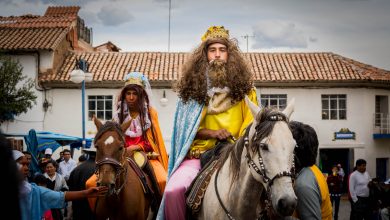Coming Together, The Lord of Temblors Roams Cuzco Today.

Power and passion beat to the sound of trumpets, bells, and hundreds of thousands of souls. The day is a slow crescendo from morning mass to the mid-morning exit of Cuzco’s supreme holy figure, a gaunt image, skin hanging from bones, who in turn hangs from a wooden cross, the Lord of Temblors. The emotion reaches a peak beyond all peaks in the city when the massive bell María Angola strikes its deep and discordant notes to the cacophony of bands and fire sirens when the Lord returns, not long after dusk, to the Cathedral for another year.
Before entering the massive doors, the figure on the shoulders of his bearers—who have taken turns for the honor and blessing of porting him around the city— turns and dips in farewell. Called “The Blessing,” this moment draws hundreds of thousands of people to be present for and to carry the gifts of grace and good fortune through another year.
This figure of Christ, ostensibly a gift from Charles the V (although the story includes trickery where another town keeps that Christ and this one is a copy, a fake) this Christ has come together with the people in Cuzco to create a passion as great or greater than any in Catholic world.
Luís Millones, the great student of popular Catholicism notes how in Peru this joining of people and holy figures organizes saint’s stories the length and breadth of Peru. Not just about the hagiography of martyrdom or of the infusion of holiness because of grace and their exemplary saintliness, the stories mark acceptance or rejection on the part of the people.

This note, whatever else one says about it, is something key in the history of Andean relationship to things that are larger or greater than people. It is an active relationship with at least two sides, not just the story of a God and his power, but one of the people transforming and making God, in this case a figure of dubious origin whose intent was as a gift from an emperor, but who was falsified, until he performed a miracle for the people of Cuzco at the time of a massive earthquake—he calmed the earth, the powerful mother of all.

As a result, the people of Cuzco betrayed the Holy Patron given to them and turned to Him. Ever since that moment in the sixteenth century, this image has been the patron of Cuzco, the one who performs as a patron should with gifts and blessings of fortune and life to his people. They in turn perform as well, with the greatest devotion in the entire repertoire of the city.
In this is an Andean tradition, the making of family and relationships of holiness through doing things for each other rather than through the acts of power, noblesse oblige, or the transcendent per se splitting away from the profane.
Being for each other, manifested in the giving of gifts to the Lord of music, dance prayer, devotion, red flowers, petitions, clothing, of care and from him to the people of constant fortune, protection—food, and safety—forms much life in the Imperial city even today in the regime of individualistic neoliberalism.
This city and its Lord live together still and today that power and passion rise in a heart wrenching passion until at night the Cathedral doors close and darkness reigns in the absence of the God as Holy Week moves on to the crucifixion and resurrection of the God for another year.




